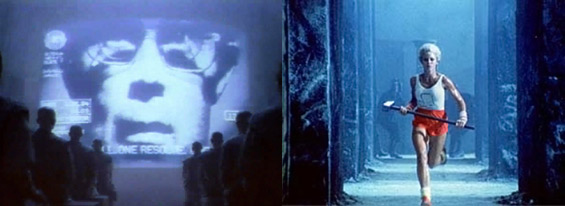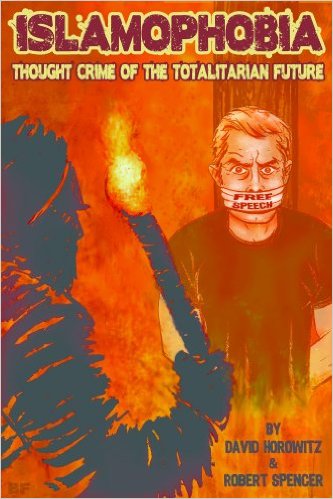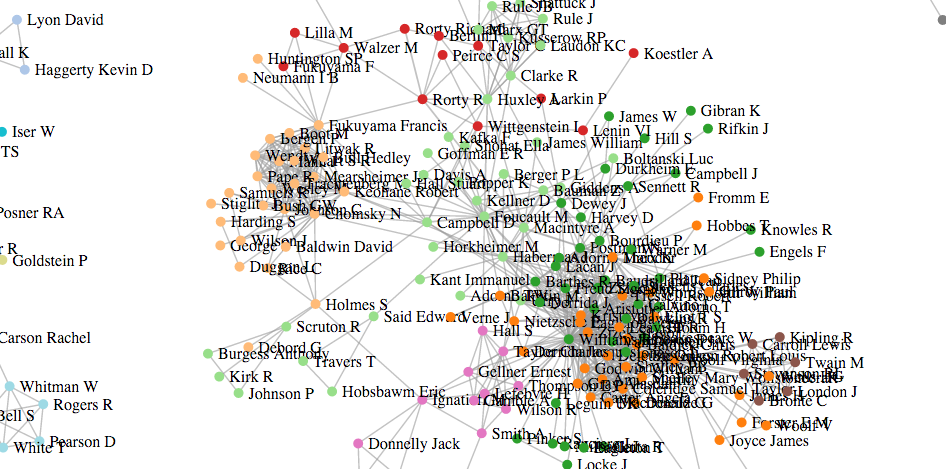Tracing 1984's Networks
Several friends and colleagues asked if I’d post my MLA 2016 talk on networks in George Orwell’s 1984, and I’m happy to oblige. It’s a sort of digital-humanities-oriented post-script to my recently completed first book, and it’s an attempt to describe how actor network theory—rather than a Foucauldian, critical paradigm—wound up informing the method for that book project. The panel, “Literary and Scientific Networks,” organized by John Savarese, also offered a good opportunity to try adapting the computationally generated co-citation networks that I’ve adapted very slightly from Neal Caren and Kieran Healy by way of Jonathan Goodwin. (Technical details on that adaptation follow at the end. This is also, for the record, a paper that I truncated substantially in delivering.)
Biopolitics and Actor Networks:
In my forthcoming book, “Human Programming: Brainwashing, Automatons, and American Unfreedom,” I was looking at the literary, scientific, and political network of discourses associated with mind control and unfreedom. How does scientific change, I began by asking, affect how we think about what freedom and unfreedom are in the twentieth century? What roles have literature and science played in producing the images of “unfreedom” that we have associated with totalitarianism, fundamentalism, and other enemies of democracy? I quickly found that the image of what Erich Fromm called the “human automaton”—the totalitarian subject as a human reduced to a machine—floated between literary and scientific discourses in a way that I found to be surprisingly omnidirectional.
That omnidirectionality seems to be worth emphasizing, as a lot of 20th-C. scholarship in literature and science that I’m familiar with emphasizes how the literary text internally processes scientific paradigms and approaches. Often the text and author together enact a critique of a scientific practice or mindset—this or that understanding of the environment, of the mind, of the disabled body, of the gene, etc.—or else the text engages in a science-fictional extrapolation of this or that science-fictional trajectory, which the critic backfills, in order to amplify its critical dimension.
In reading recent debates about reading methods and critique (including Rita Felski’s The Limits of Critique and several works by Bruno Latour) I’ve been wondering to what extent critique in a Foucauldian vein has been a dominant presence in the literature and science subfield in the twentieth century. Particularly when we emphasize science as discipline—in the senses of ruling over, normalization, or of scientific knowledge as biopower—we place ourselves in danger of reproducing a two-cultures divide, wherein we find science as a dehumanizing and instrumental, and either the critic or the literary text itself as resisting that force through gestures of unmasking. (Such a split between the human and inhuman, figured in the critic’s stance outside an otherwise totalizing biopolitical regime, is often borrowed second- or third-hand, I found in my research, from Cold War-era rhetoric about humane democracy and automaton totalitarianism.)
While I don’t believe that critique has altogether “run out of steam,” and while I think there are still useful and necessary exemplars of such critique in this subfield and others, I also have found myself in search of alternatives, and for new modes of talking about the political and scientific impact of literary texts aside from their power to critique various forms of scientifically enabled biopower. The latter approach seemed particularly unsuited to my own object of study, which I’ll try to describe through the example of 1984.
Bruno Latour’s actor-network theory, for me as for many others, has been useful in pointing out new directions. A good sociological study, he writes, is one that “traces a network,” and it’s been interesting to think about what that might mean for literary studies, and for studying literature and science in the twentieth century. Felski suggests interestingly, drawing on Latour’s work on nonhuman actors, that we understand literary works as just such “actants”: mediators within our networks of exchange of ideas, images, and styles of thinking.
It’s in trying to feel out such an approach that we stand to learn something about networks and about the agency of literary texts, namely whether and how moving from a Foucauldian paradigm—or better, pole, or end of a spectrum of practices—to a Latourian pole (a biopolitical to an actor-network-theory of the cultures of science) really makes a difference in what we do and how. (And again, I think there are terrific works that already do this: Priscilla Wald’s Contagious: Cultures, Carriers, and the Outbreak Narrative (Duke, 2008) is a terrific example of a network-tracing work that has served as a methodological model for me.) That’s the big question motivating this talk; my provisional answer is that it subtly shifts how we talk about the political impact of literary texts.
1984 ’s Networks:
Orwell’s 1984 has two well-known scientific sources: one in B.F. Skinner’s “Little Albert” experiment that Orwell adapts and heavily embellishes in the novel’s climactic torture scene involving rats. The second is, as Orwell’s biographers have noted, linguistic, in Orwell’s enthusiasm for an Esperanto-like language and in his adoption, through the concept of “NewSpeak,” of the Sapir-Whorf hypothesis wherein language shapes and limits a speaker’s worldview or ideology. With regard to both, Orwell writes with an oppositional spirit against the mid-twentieth-century’s technocracy, in a way I think has been influential. But much more interesting to me is the network of literature and science that arrives in the novel’s wake. I knew something of the “footprint” of 1984’s ideas and images before going into my broader project, but it kept coming up, and its adaptability has seemed endless. It’s the full-on blueprint for texts including George Lucas’s THX 1138, David Bowie’s Diamond Dogs, and Apple’s most famous and most deeply nonsensical advertisement, from the 1984 Superbowl.

Apple’s “1984” ad for the Macintosh
More substantially, Orwell’s novel also participated in U.S. political culture. It warrants mention by George Kennan, the chief architect of the Cold War, who said in 1953, “When I try to picture totalitarianism to myself as a general phenomenon, what comes to mind most prominently is neither the Soviet picture nor the Nazi picture as I have known them in the flesh, but rather the fictional and symbolic images created by such people as Orwell or Kafka or Koestler or the early Soviet satirists.” 1984 was an inspiration to Edward Hunter, the CIA man who coined the term “brainwashing” to describe Chinese Thought Reform and the psychology of Korean War POWs. (“Brainwashing,” too, as I trace in my book, has floated between scientific discourses and popular and legal narratives ever since.) And the language introduced in 1984, in words like “Big Brother” and “Thoughtcrime,” has been endlessly adapted in rhetoric on the political left and right with surprising consistency. Far right academics David Horowitz and David Spencer recently co-authored a book entitled, Islamophobia: Thought Crime of a Totalitarian Future (David Horowitz Freedom Center, 2011) which imagines, as many right-wing pundits do, that political correctness is itself a totalitarian or technocratic imposition of limitations on language and thought.

Rhetoric from Orwell’s novel adapted by the U.S. far right
When thinking of this kind of footprint for a work, it’s a moment where close-reading to find (what I presume to be) its “real meaning” and its “real politics” within its depths—to show the autonomous and whole work of art has its own critical voice—seems like precisely the wrong strategy. 1984 is most alive as a collection of powerful images and rhetorical strategies that roam freely in the world, through a network of often loose attachments to readers. (This is how the notion of the text as an “actant” makes sense to me.)
To my surprise, as I continued with this research I found that 1984 is also a text that worked its way into scientific and other academic discourse, and offered scientists strategies for communicating ideas and making their political consequences vivid. In my research about ideas of freedom and unfreedom, Orwell and 1984 kept cropping up, sometimes as shorthands or for points of analogy, but still, quite consistently, and even then, the work itself seemed surprisingly present in the works about totalitarianism and thought control that I was reading, not just in sociology and political science but also in psychiatry and psychology: Robert Jay Lifton’s Thought Reform and the Psychology of Totalism, Joost Meerloo’s Rape of the Mind, expert testimony on cults, and popular discussions of fundamentalism, too, had references to Orwell and 1984.
While my book doesn’t ultimately spend much time with Orwell, I started to wonder how one might study this footprint or network of Orwell in the sciences more systematically, which is what I’ll think about for the rest of today’s paper.
Anecdotally, 1984 doesn’t seem to be a text that’s read or taught terribly much at the university level, despite its having been a very popular book. It remains (again anecdotally) on high school English curricula in the U.S., and it was a Book-of-the-Month Club book on its release. I get the sense that the book is almost too straightforward, or too simple in its anti-totalitarian message, to warrant much explication by literary critics, a number of interesting essays and volumes and a Cambridge Companion notwithstanding. (Cases where a clearly influential book doesn’t get studied all that much can I think be illuminating, for what kinds of differentiation or distinction quietly circumscribe our choices of what works to study, and what’s worth studying about them.)
Despite having this sense, nothing could have prepared me for seeing a list of the most-cited articles with “Orwell” in their title or abstract, from Web of Science’s industry-standard citation database. Even though it’s not entirely comprehensive in its listings of humanities journals, it was still a surprise that the top 5 most-cited articles on Orwell weren’t from literary studies at all: they were from The British Journal of Sociology (321 citations), Stanford Law Review (71), Language(32), American Scientist (12), and Computers and the Humanities (11). The Cambridge Companion to George Orwell was number 6, and Web of Science found 9 citations of it. It was followed by other articles from literary studies, management studies, geography, psychoanalysis, political science, and public policy in the top 20.
I then decided to search for just articles on Web of Science that cite 1984, and then ordered them by how often they’d been cited. My top result there, which I’ll return to, was from The Journal of Management Studies, erroneously missing from the prior table, but cited 388 times (including being cited by one of the top results in the other table). It’s by Hugh Willmott, entitled, “Strength is Ignorance, Slavery is Freedom: Managing Culture in Modern Organizations.” We’ll return to it.
I wanted to get a more systematic and complete picture, based off data found in Web of Science, of what Orwell’s footprint looked like. I wound up deciding to adapt an indirect digital strategy for doing so. Co-citation networks are a method that I’ve borrowed here from Dan Wang, Neal Caren, Kieran Healy, and Jonathan Goodwin. (I’ve also been inspired by related strategies in work by Andrew Goldstone, Ted Underwood, Hoyt Long, Richard So, and Ed Finn.) They’ve been using these visualizations to give empirical snapshots of different journals and fields, based on what thinkers or works are cited together most frequently, and in what clusters. Here’s what that looks like, and you can click through to see the dynamic, draggable version:

A cocitation network for works that cite 1984
I decided to adapt their model somewhat in order to look at all the texts that cite 1984. Because it’s using others’ citation of a wide variety of other works, conceivably from any time period, this picture is emphatically not showing an influence study. Instead, what we get is a sort of ludic chart of what I’m calling (because I do the U.S. mid-century) Orwell’s “fellow travelers”: we see here regions with other thinkers whose work is used alongside Orwell’s within different fields and in different topics. It can let us explore the different kinds of academic uses of 1984, from linguistics to philosophy, political science, and sociology, psychology and other little clusters, like anthropology, that threaten to float off-screen here. This turned out to be less directly informative than I’d hoped, because the most-cited, and most central works here tend to be of broad, interdisciplinary importance. So we see less separation by discipline than I’d expected. Nonetheless, it’s still a potentially useful tool or approach for other literary fiction, to look at the different cohorts of thinkers that scholars bring them into conversation with. (This might complement Ed Finn’s interesting work in a similar vein on the ways authors are cited together in book reviews.). Studies of other authors with this might range from the potentially fascinating (Toni Morrison?) to the almost certainly depressing (Ayn Rand).
While the co-citation network can serve in the future (and for other texts) as a kind of discovery device, it was actually just the most-cited article that fascinated me most, Willmott’s “Strength Is Ignorance, Slavery Is Freedom: Managing Culture in Modern Organizations.” The article critically describes what it names “corporate culturism”: the soft power of promoting “culture,” from the jargon of achievement to the value of the corporate retreat, in HR and management theory. The article cites Foucault, Marx, Weber, David Harvey, the philosopher Alisdair Macintyre, and many others, in addition to figures from its own business-school discipline. But most interesting to me obviously is the very central role of 1984: frequent quotations from Orwell offer a way of structuring the argument through the whole first half of the article. I’d contend that Orwell’s main function is as a kind of rhetorical bridge: Orwell is deployed toward what I imagine to be a peer-review readership in a discipline that may well have been resistant to Marx or Foucault. Willmott’s accusation that his management theory peers are using doublespeak, would, in my hypothesis, encourage readers who might be resistant to symptomatic reading strategies to engage in them. The gambit of accusing these corporate culturists of being like the Party is an astoundingly successful one, especially given how often the article has been cited. And is there anything Americans can agree on more than our desire to not be Orwell’s Party, and the desire to dislike whoever resembles them? The consensus I’ve seen in my research has been nothing short of astounding.
And so while it winds up being subtle, to me 1984’s political impact resides in the ways that it has shaped, and continues to shape popular and sometimes scientific discussions about power. (And, as Katie Fitzpatrick observed in a conversation after the panel, literature is the source of surprising amount of our vocabulary for talking about social structures, from the Dickensian to the Kafkaesque and the Orwellian.)
Digital Details:
I first encountered cocitation graphs as a discovery tool in this post by Jonathan Goodwin on his personal blog. It links to several examples of its use and different adaptations Goodwin made, and to Caren’s original code for generating the d3.js force layout diagram. A fully elaborated example of Goodwin’s work on a single journal can be found on the Signs @ 40 site for the journal Signs.
Caren, Healy, and Goodwin did a Web of Science search through whole journals; my searches were instead for “Orwell” in the articles’ bibliographic entries. Although I initially thought I might modify the code substantially, I made just one change to Caren’s code, which was to pull only the names of selected entries, rather than the name and year, and then to lower the thresholds so that entries only had to be cited together twice in order to show up together. (This was necessary because I had a more diffuse dataset with fewer co-citations.) I wound up just using sed (the command line’s “find and replace”) to remove all the entries authored by Orwell (whose presence would make the graph fittingly, if uninformatively, panopticon-like) directly within the text file, which the python script then reads. Web of Science pulls a lot of data, so it would be possible to color entries by shared discipline rather than by community detection algorithm, to size nodes according to various criteria. Again, I intended this cocitation graph to be more of a playful proof-of-concept than to show anything conclusive, and I’d be excited to see others take this kind of work in new directions.